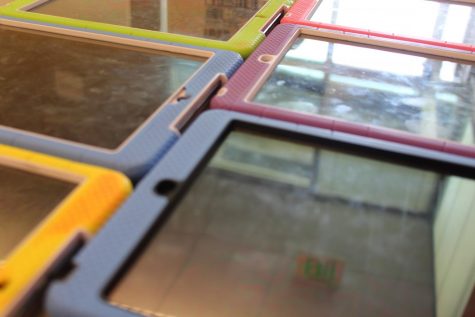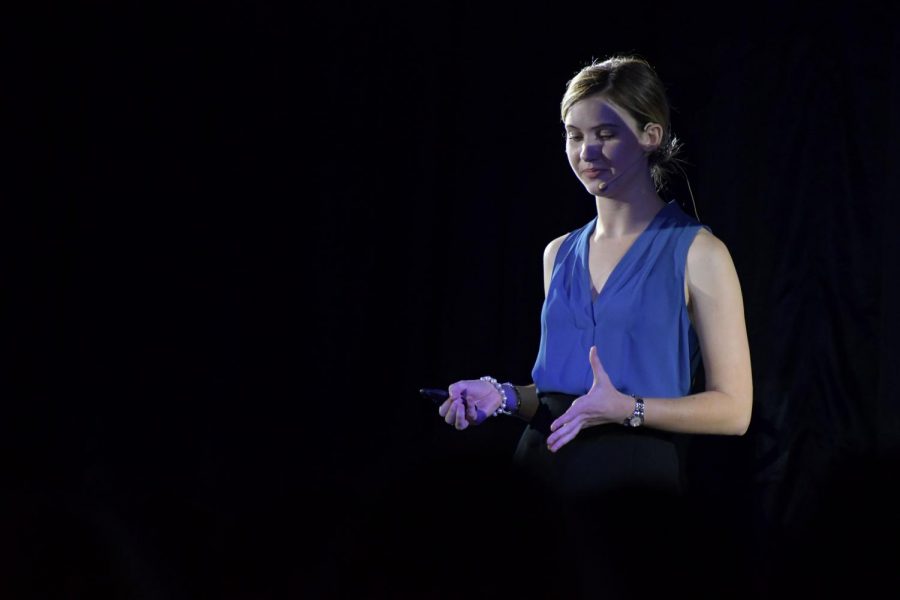Alexis McBride: Germ Buster
Senior Alexis McBride single handedly formulated her own experiment in order to showcase the unsanitary utility that makes up the ipads within the mathematics department here on the Sage Creek Campus. Through her research, McBride was able to construct a charging and disinfectant cabinet in which the devices can be placed in when not in use. With the help of her father with constructing the cart and the implementation of UV rays within her conception, McBrides Genius Project lead to an impactful and impressive product.
May 31, 2018
As a self-proclaimed germaphobe, senior Alexis McBride notices when little Jimmy sits sweating with a 103-degree fever at the next table over, when Richard sneezes directly onto his iPad and switches with his tablemates, when Donna picks her nose and wipes it on said iPad. After observing these traumatic experiences, McBride has made it her mission to tackle germs and viruses ever present on the school’s numerous iPads by developing an iPad locker with UV sterilization technology.
Not only did McBride’s grit, professionalism, and ingenuity help her in college applications, but it also landed her a spot as one of the eight speakers to give their TED Talks at the prestigious Genius Project symposium.
It’s no secret that students at Sage Creek take their academics very seriously, a large proportion taking one or more AP classes. And when these students get sick, most of the time they’ll still go to school for fear of falling behind, hence continuing the spread of germs. McBride not only wants to eliminate potential viruses that could be transferred to healthy students, she also wants to keep the sick students from spreading germs via the iPads.
“iPads in the classrooms might be a significant disease carrier at our school considering that it is shared by everybody and students aren’t exactly washing their hands in between each use,” McBride said.
Now McBride didn’t just jump into creating the iPad cart right away, she first proved that there is a need for such measures and that UV sterilization is, in fact, effective. Having taken the Project Lead the Way (PLTW) biomedical science path all four years and founding the Biomed club McBride understands the importance of following proper scientific procedures.
“I swabbed two iPads from each of five classrooms, sterilizing one with UV lights and leaving the other untreated. I grew the swabs on special agar plates which supported only gram-positive bacterial growth in order to better identify pathogenic bacteria,” McBride said.
McBride conducted a trial using swabs from untreated iPads as the constant and then treating two other sets of iPads with the UV treatment and then just wiping down the other with Clorox wipes.
 Justin Storrs
Justin Storrs
“[The] results are very supportive of my hypothesis that UV lights can be used to reduce the population of pathogenic bacteria living on our class iPads,” McBride said.
McBride would often conduct these experiments on her own free time after school in biomedical teacher Valerie Park’s classroom.
“She basically used the incubator in my classroom and I would help her take some pictures of her bacterial growth and help her clean up properly as it was harmful bacteria and we wanted to make sure that it was properly taken care [of],” Park said.
Tackling the complex experiments came easily to the longtime Biomed student, however, the real challenge came with actually building the cabinet.
“I had been able to rely on my background in science for the research phase of my project, but I soon came to the realization that actually building the prototype would require knowledge that I simply didn’t have,” McBride said.
However McBride pushed through and after getting a grant from the PTSA, she began buying the necessary supplies. Three stackable cabinets, some UV lights, a surge protector and some help from her dad later the prototype was completed and ready for testing.
“I have [now] a working iPad cabinet capable of charging and sterilizing six iPads at once,” Mcbride said.
The math department has already expressed their interest in the project as often times it is too time-consuming to sterilize the iPads every day. Math teacher Domenic Manente tries to sterilize his iPads as much as possible, but even then it’s often difficult to ensure cleanliness.
“[A UV cart] would be amazing, that would be a great help, that would significantly improve the cleanliness of the iPads. I would really appreciate that,” Manente said.
The germ problem goes unnoticed for most students; however, once the idea is pitched, most of them will agree that the iPads are in dire need of sterilization. Senior Mark Ibraham has been using iPads for his entire high school career but has never thought about the hidden menace.
“Now that I think about it there are always a ton of fingerprints and it’s kinda greasy … so I guess the UV ray thing killing all the germs is a good project,” Ibrahim said.
In the end, McBride’s experience of designing and building the cabinet gave her the upper hand in her college admissions as she is now committed to UC Davis majoring in global disease biology. As for the school, her cabinet gives students the upper hand in fighting germs, staying healthy and not falling behind due to sickness.







Andrew Coviello ◊ May 31, 2018 at 2:19 pm
Great invention! Now let’s open up to Sage Creek students about how you can take twice the amount of time you missed to make up your absent work.